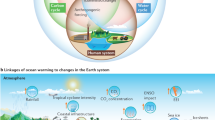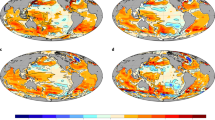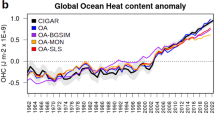Abstract
The ocean absorbs most of the excess heat from anthropogenic climate change, causing global ocean warming and sea-level rise with a series of consequences for human society and marine ecosystems. While there have been ongoing efforts to address large uncertainties in future projections, to date the projected ocean warming has not been constrained by the historical observations. Here, we show that the observed ocean warming over the well-sampled Argo period (2005–2019) can constrain projections of future ocean warming and that the upper-tail projections from latest climate models with high climate sensitivities are unrealistically large. By 2081–2100, under the high-emission scenario, the upper 2,000 m of the ocean is likely (>66% probability) to warm by 1,546–2,170 ZJ relative to 2005–2019, corresponding to 17–26 cm sea-level rise from thermal expansion. Further narrowing uncertainties requires maintenance of the ocean observing system to extend the observational record.
This is a preview of subscription content, access via your institution
Access options
Access Nature and 54 other Nature Portfolio journals
Get Nature+, our best-value online-access subscription
$29.99 / 30 days
cancel any time
Subscribe to this journal
Receive 12 print issues and online access
$209.00 per year
only $17.42 per issue
Buy this article
- Purchase on Springer Link
- Instant access to full article PDF
Prices may be subject to local taxes which are calculated during checkout



Similar content being viewed by others
Data availability
The CMIP5 and CMIP6 climate-model outputs are available at https://esgf-node.llnl.gov/projects/esgf-llnl/. All observational datasets used in this study are publicly available online (links are listed in Supplementary Table 2).
Code availability
The code used to generate the main figures and to derive the constrained projections based on the emergent constraint methodology is available from a Figshare repository64.
References
Hansen, J. et al. Earth’s energy imbalance: confirmation and implications. Science 308, 1431–1435 (2005).
von Schuckmann, K. et al. Heat stored in the Earth system: where does the energy go? Earth Syst. Sci. Data 12, 2013–2041 (2020).
Von Schuckmann, K. et al. An imperative to monitor Earth’s energy imbalance. Nat. Clim. Change 6, 138–144 (2016).
Meyssignac, B. et al. Measuring global ocean heat content to estimate the Earth energy imbalance. Front. Mar. Sci. 6, 432 (2019).
WCRP Global Sea Level Budget Group Global sea-level budget 1993–present. Earth Syst. Sci. Data 10, 1551–1590 (2018).
Rignot, E., Jacobs, S., Mouginot, J. & Scheuchl, B. Ice-shelf melting around Antarctica. Science 341, 266–270 (2013).
Trenberth, K. E., Cheng, L., Jacobs, P., Zhang, Y. & Fasullo, J. Hurricane Harvey links to ocean heat content and climate change adaptation. Earth’s Future 6, 730–744 (2018).
Bindoff, N. L. et al. in Special Report on the Ocean and Cryosphere in a Changing Climate (eds Pörtner, H.-O. et al.) Ch. 5 (IPCC, 2019).
Durack, P. J., Gleckler, P. J., Landerer, F. W. & Taylor, K. E. Quantifying underestimates of long-term upper-ocean warming. Nat. Clim. Change 4, 999–1005 (2014).
Roemmich, D. et al. Unabated planetary warming and its ocean structure since 2006. Nat. Clim. Change 5, 240–245 (2015).
Wijffels, S., Roemmich, D., Monselesan, D., Church, J. A. & Gilson, J. Ocean temperatures chronicle the ongoing warming of Earth. Nat. Clim. Change 6, 116–118 (2016).
Johnson, G. C. et al. Ocean heat content. Bull. Am. Meteorol. Soc. 101, S140–S144 (2020).
Church, J. A. et al. in Climate Change 2013: The Physical Science Basis (eds Stocker, T. F. et al.) Ch. 13 (IPCC, Cambridge Univ. Press, 2013).
Gregory, J. M. et al. The Flux-Anomaly-Forced Model Intercomparison Project (FAFMIP) contribution to CMIP6: investigation of sea-level and ocean climate change in response to CO2 forcing. Geosci. Model Dev. 9, 3993–4017 (2016).
Domingues, C. M. et al. Improved estimates of upper-ocean warming and multi-decadal sea-level rise. Nature 453, 1090–1093 (2008).
Gleckler, P. J. et al. Human-induced global ocean warming on multidecadal timescales. Nat. Clim. Change 2, 524–529 (2012).
Slangen, A. B. A., Church, J. A., Zhang, X. & Monselesan, D. Detection and attribution of global mean thermosteric sea level change. Geophys. Res. Lett. 41, 5951–5959 (2014).
Gleckler, P. J., Durack, P. J., Stouffer, R. J., Johnson, G. C. & Forest, C. E. Industrial-era global ocean heat uptake doubles in recent decades. Nat. Clim. Change 6, 394–398 (2016).
Cheng, L., Abraham, J., Hausfather, Z. & Trenberth, K. E. How fast are the oceans warming? Science 363, 128–129 (2019).
Jevrejeva, S., Palanisamy, H. & Jackson, L. P. Global mean thermosteric sea level projections by 2100 in CMIP6 climate models. Environ. Res. Lett. 16, 014028 (2021).
Mengel, M. et al. Future sea level rise constrained by observations and long-term commitment. Proc. Natl Acad. Sci. USA 113, 2597–2602 (2016).
Tokarska, K. B., Hegerl, G. C., Schurer, A. P., Ribes, A. & Fasullo, J. T. Quantifying human contributions to past and future ocean warming and thermosteric sea level rise. Environ. Res. Lett. 14, 074020 (2019).
Tokarska, K. B., Hegerl, G. C., Schurer, A. P., Forster, P. M. & Marvel, K. Observational constraints on the effective climate sensitivity from the historical period. Environ. Res. Lett. 15, 034043 (2020).
Forster, P. M., Maycock, A. C., McKenna, C. M. & Smith, C. J. Latest climate models confirm need for urgent mitigation. Nat. Clim. Change 10, 7–10 (2020).
Zelinka, M. D. et al. Causes of higher climate sensitivity in CMIP6 models. Geophys. Res. Lett. 47, e2019GL085782 (2020).
Stevens, B., Sherwood, S. C., Bony, S. & Webb, M. J. Prospects for narrowing bounds on Earth’s equilibrium climate sensitivity. Earths Future 4, 512–522 (2016).
Newsom, E., Zanna, L., Khatiwala, S. & Gregory, J. M. The influence of warming patterns on passive ocean heat uptake. Geophys. Res. Lett. 47, e2020GL088429 (2020).
Hall, A., Cox, P., Huntingford, C. & Klein, S. Progressing emergent constraints on future climate change. Nat. Clim. Change 9, 269–278 (2019).
Myhre, G. et al. in Climate Change 2013: The Physical Science Basis (eds Stocker, T. F. et al.) Ch. 8 (IPCC, Cambridge Univ. Press, 2013).
Church, J. A., White, N. J. & Arblaster, J. M. Significant decadal-scale impact of volcanic eruptions on sea level and ocean heat content. Nature 438, 74–77 (2005).
Jiménez-de-la-Cuesta, D. & Mauritsen, T. Emergent constraints on Earth’s transient and equilibrium response to doubled CO2 from post-1970s global warming. Nat. Geosci. 12, 902–905 (2019).
Nijsse, F. J., Cox, P. M. & Williamson, M. S. Emergent constraints on transient climate response (TCR) and equilibrium climate sensitivity (ECS) from historical warming in CMIP5 and CMIP6 models. Earth Syst. Dyn. 11, 737–750 (2020).
Tokarska, K. B. et al. Past warming trend constrains future warming in CMIP6 models. Sci. Adv. 6, eaaz9549 (2020).
Gregory, J. M. & Andrews, T. Variation in climate sensitivity and feedback parameters during the historical period. Geophys. Res. Lett. 43, 3911–3920 (2016).
Andrews, T. et al. Accounting for changing temperature patterns increases historical estimates of climate sensitivity. Geophys. Res. Lett. 45, 8490–8499 (2018).
Cheng, L. et al. Evolution of ocean heat content related to ENSO. J. Clim. 32, 3529–3556 (2019).
Wu, Q., Zhang, X., Church, J. A. & Hu, J. ENSO-related global ocean heat content variations. J. Clim. 32, 45–68 (2019).
Brown, P. T., Li, W., Li, L. & Ming, Y. Top-of-atmosphere radiative contribution to unforced decadal global temperature variability in climate models. Geophys. Res. Lett. 41, 5175–5183 (2014).
Palmer, M. D. & McNeall, D. J. Internal variability of Earth’s energy budget simulated by CMIP5 climate models. Environ. Res. Lett. 9, 034016 (2014).
Johnson, G. C. & Birnbaum, A. N. As El Niño builds, Pacific Warm Pool expands, ocean gains more heat. Geophys. Res. Lett. 44, 438–445 (2017).
Durack, P. J. et al. Ocean warming: from the surface to the deep in observations and models. Oceanography 31, 41–51 (2018).
Gregory, J. M., Andrews, T., Ceppi, P., Mauritsen, T. & Webb, M. J. How accurately can the climate sensitivity to CO2 be estimated from historical climate change? Clim. Dyn. 54, 129–157 (2020).
Menary, M. B. et al. Aerosol-forced AMOC changes in CMIP6 historical simulations. Geophys. Res. Lett. 47, e2020GL088166 (2020).
Smith, C. et al. Energy budget constraints on the time history of aerosol forcing and climate sensitivity. J. Geophys. Res. Atmos. https://doi.org/10.1029/2020JD033622 (2021).
Sherwood, S. C. et al. An assessment of Earth’s climate sensitivity using multiple lines of evidence. Rev. Geophys. 58, e2019RG000678 (2020).
Johnson, G. C. & Lyman, J. M. Warming trends increasingly dominate global ocean. Nat. Clim. Change 10, 757–761 (2020).
Seroussi, H. et al. ISMIP6 Antarctica: a multi-model ensemble of the Antarctic ice sheet evolution over the 21st century. Cryosphere 14, 3033–3070 (2020).
Zika, J. D., Gregory, J. M., McDonagh, E. L., Marzocchi, A. & Clement, L. Recent water mass changes reveal mechanisms of ocean warming. J. Clim. 34, 3461–3479 (2021).
Roemmich, D. et al. On the future of Argo: a global, full-depth, multi-disciplinary array. Front. Mar. Sci. 6, 439 (2019).
Winton, M. et al. Climate sensitivity of GFDL’s CM4.0. J. Adv. Model. Earth Syst. 12, e2019MS001838 (2020).
Sen Gupta, A., Jourdain, N. C., Brown, J. N. & Monselesan, D. Climate drift in the CMIP5 models. J. Clim. 26, 8597–8615 (2013).
Li, H. et al. Development of a global gridded Argo data set with Barnes successive corrections. J. Geophys. Res. Oceans 122, 866–889 (2017).
Gaillard, F., Reynaud, T., Thierry, V., Kolodziejczyk, N. & Von Schuckmann, K. In situ–based reanalysis of the global ocean temperature and salinity with ISAS: variability of the heat content and steric height. J. Clim. 29, 1305–1323 (2016).
Hosoda, S., Ohira, T. & Nakamura, T. A monthly mean dataset of global oceanic temperature and salinity derived from Argo float observations. JAMSTEC Rep. Res. Dev. 8, 47–59 (2008).
Roemmich, D. & Gilson, J. The 2004–2008 mean and annual cycle of temperature, salinity, and steric height in the global ocean from the Argo Program. Prog. Oceanogr. 82, 81–100 (2009).
Argo Float Data and Metadata from Global Data Assembly Centre (Argo GDAC) (SEANOE, 2000); https://doi.org/10.17882/42182
Cheng, L. et al. Improved estimates of ocean heat content from 1960 to 2015. Sci. Adv. 3, e1601545 (2017).
Ishii, M. et al. Accuracy of global upper ocean heat content estimation expected from present observational data sets. SOLA 13, 163–167 (2017).
Levitus, S. et al. World ocean heat content and thermosteric sea level change (0–2000 m), 1955–2010. Geophys. Res. Lett. 39, L10603 (2012).
Zhang, X. & Church, J. A. Sea level trends, interannual and decadal variability in the Pacific Ocean. Geophys. Res. Lett. 39, L21701 (2012).
Cox, P. M. et al. Sensitivity of tropical carbon to climate change constrained by carbon dioxide variability. Nature 494, 341–344 (2013).
Cox, P. M., Huntingford, C. & Williamson, M. S. Emergent constraint on equilibrium climate sensitivity from global temperature variability. Nature 553, 319–322 (2018).
Charles, E., Meyssignac, B. & Ribes, A. Observational constraint on greenhouse gas and aerosol contributions to global ocean heat content changes. J. Clim. 33, 10579–10591 (2020).
Lyu, K., Zhang, X. & Church, J. A. Projected ocean warming constrained by the ocean observational record: supplementary metadata. Figshare https://doi.org/10.6084/m9.figshare.15063063 (2021).
Acknowledgements
This study was supported by the Centre for Southern Hemisphere Oceans Research (CSHOR), jointly funded by the Qingdao National Laboratory for Marine Science and Technology (QNLM, China) and the Commonwealth Scientific and Industrial Research Organisation (CSIRO, Australia). J.A.C. was also funded by the Australian Research Council’s Discovery Project funding scheme (project DP190101173). This research was undertaken with the assistance of resources from the National Computational Infrastructure (NCI Australia), an NCRIS enabled capability supported by the Australian Government. We thank Q. Wu for helpful discussions. We acknowledge the World Climate Research Programme, which, through its Working Group on Coupled Modelling, coordinated and promoted CMIP. We thank the climate modelling groups (listed in Supplementary Table 1) for producing and making available their model output, the Earth System Grid Federation (ESGF) for archiving the data and providing access, and the multiple funding agencies who support CMIP and ESGF. Argo data were collected and made freely available by the International Argo Program and the national programmes that contribute to it (https://argo.ucsd.edu, https://www.ocean-ops.org). The Argo Program is part of the Global Ocean Observing System.
Author information
Authors and Affiliations
Contributions
J.A.C. initiated the idea of this study. K.L. carried out the analysis under the guidance of J.A.C. and X.Z. and wrote the first draft. All authors contributed to designing the study, interpreting the results and revising the manuscript.
Corresponding authors
Ethics declarations
Competing interests
The authors declare no competing interests.
Additional information
Peer review information Nature Climate Change thanks Dewi Le Bars and the other, anonymous, reviewer(s) for their contribution to the peer review of this work.
Publisher’s note Springer Nature remains neutral with regard to jurisdictional claims in published maps and institutional affiliations.
Extended data
Extended Data Fig. 1 Relationship between the equilibrium climate sensitivity (ECS) and global OHC projections.
Scatterplot of projected 0–2000 m global OHC changes (2081–2100 relative to 2005–2019) against the ECS values from the CMIP6 (black) and CMIP5 (grey) models. The linear fits are shown although their relationship might not be expected to be linear31,32. (a) high-emission scenarios; (b) medium-emission scenarios; (c) low-emission scenarios.
Extended Data Fig. 2 Impact of the decadal ENSO variability on the observed near-global OHC change over the Argo period.
a, The Niño 3.4 index (black) and its linear fit (red) over 2005–2019. b, The near-global OHC time series over 2005–2019 from the Scripps Argo product (black) and its linear fit (red). The magenta line shows the multiple linear regression based on both the linear trend and the Niño 3.4 index (see Methods).
Extended Data Fig. 3 Emergent constraints on the global OHC projections under medium- and low-emission scenarios.
Scatterplot of projected 0–2000 m global OHC changes (2081–2100 relative to 2005–2019) against simulated 0–2000m near-global OHC changes over 2005–2019 from the CMIP6 ensemble. (a) medium-emission scenario SSP2-4.5; (b) low-emission scenario SSP1-2.6. Triangles are for the individual CMIP6 models (labelled by letters defined in Supplementary Table 1), with colours indicating the equilibrium climate sensitivity (ECS) range. The solid black line shows the linear regression across the CMIP6 ensemble and the dashed black lines show the prediction errors for the linear fit (68% confidence intervals). The vertical magenta line shows the observed trend over 2005–2019 averaged from eight observational datasets after correcting for decadal ENSO effect. The dashed magenta lines show the ±1 standard deviation uncertainty range in the observed trend, considering both spread between different datasets and uncertainty due to internal variability (see Methods).
Extended Data Fig. 4 The probability density function (PDF) for the linear regression from the model-derived emergent relationship and its combination with the observational estimate.
a, The PDF for the linear regression between projected 0–2000 m global OHC changes (2081–2100 relative to 2005–2019) under SSP5-8.5 and simulated 0–2000 m near-global OHC changes over 2005–2019 from 28 CMIP6 models as shown in Fig. 3a. b, The product of the linear regression PDF and the PDF from the observational estimate. The solid black line shows the linear regression across the model ensemble and the dashed black lines show the prediction error for the linear fit (68% confidence intervals). The vertical red lines in (b) show the observed trend over 2005–2019 after correcting for decadal ENSO effect and its uncertainty range.
Extended Data Fig. 5 The histogram of the residuals for the linear regression in Fig. 3a and the fitted probability distributions.
(black) normal distribution; (blue) logistic distribution; (brown) t location-scale distribution.
Extended Data Fig. 6 Emergent relationship between the simulated ocean warming over 2005–2019 and the projected future ocean warming from the CMIP5 ensemble under the high-emission scenario.
Scatterplot of projected 0–2000 m global OHC changes (2081–2100 relative to 2005–2019) against simulated 0–2000 m near-global OHC changes over 2005–2019 from 23 CMIP5 models under RCP8.5. Grey triangles are for the individual CMIP5 models. The solid black line shows the linear regression across the model ensemble and the dashed black lines show the prediction error for the linear fit (68% confidence intervals).
Extended Data Fig. 7 Emergent relationship between the simulated ocean warming over 2005–2019 and the projected future warming in four ocean basins under the high-emission scenario.
a, Southern Ocean (30°–90°S); b, Indian Ocean (20°–120°E, 30°N–30°S); c, Pacific Ocean (120°E–80°W, 70°N–30°S); d, Atlantic Ocean (80°W–20°E, 70°N–30°S). Triangles are for the individual CMIP6 models (labelled by letters defined in Supplementary Table 1), with colours indicating the equilibrium climate sensitivity (ECS) range. The solid black line shows the linear regression across the model ensemble and the dashed black lines show the prediction errors for the linear fit (68% confidence intervals).
Supplementary information
Supplementary Information
Supplementary Tables 1–3.
Rights and permissions
About this article
Cite this article
Lyu, K., Zhang, X. & Church, J.A. Projected ocean warming constrained by the ocean observational record. Nat. Clim. Chang. 11, 834–839 (2021). https://doi.org/10.1038/s41558-021-01151-1
Received:
Accepted:
Published:
Issue Date:
DOI: https://doi.org/10.1038/s41558-021-01151-1
This article is cited by
-
Twenty years of ocean observations with China Argo
Acta Oceanologica Sinica (2023)
-
Evolution of trends in North Atlantic dynamic sea level in the twenty-first century
Climate Dynamics (2023)
-
Past and future ocean warming
Nature Reviews Earth & Environment (2022)



